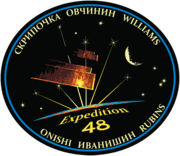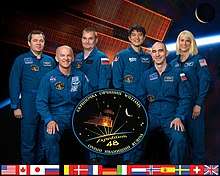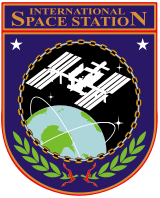Expedition 48
Expedition 48 was the 48th expedition to the International Space Station.
| Mission type | ISS Expedition |
|---|---|
| Expedition | |
| Space Station | International Space Station |
| Began | 18 June 2016 05:52 UTC[1] |
| Ended | 7 September 2016 UTC |
| Arrived aboard | Soyuz TMA-20M Soyuz MS-01 |
| Departed aboard | Soyuz TMA-20M Soyuz MS-01 |
| Crew | |
| Crew size | 6 |
| Members | Expedition 47/48: Aleksey Ovchinin Oleg Skripochka Jeffrey Williams Expedition 48/49: Kathleen Rubins Anatoli Ivanishin Takuya Onishi |
  (l-r) Skripochka, Williams, Ovchinin, Onishi, Ivanishin, Rubins | |

Sunrise panorama taken by Jeff Williams during Expedition 48.
Jeffrey Williams, Aleksey Ovchinin and Oleg Skripochka transferred from Expedition 47. Expedition 48 began upon the departure of Soyuz TMA-19M in 18 June 2016[1] and concluded upon the departure of Soyuz TMA-20M on September 6, 2016. The crew of Soyuz MS-01 were transferred to Expedition 49.[2][3][4]
Crew
| Position | First Part (June 2016) |
Second Part (July 2016 to September 2016)[5] |
|---|---|---|
| Commander | Fourth spaceflight | |
| Flight Engineer 1 | First spaceflight | |
| Flight Engineer 2 | Second spaceflight | |
| Flight Engineer 4 | Second Spaceflight | |
| Flight Engineer 5 | First Spaceflight | |
| Flight Engineer 6 | First spaceflight | |
EVA performed
| Spacewalkers | Start (UTC) | End (UTC) | Duration | |||
| 1. | August 19, 2016 13:04 |
August 19, 2016 19:02 |
5 hours 58 minutes | |||
| Installation of the International Docking Adapter (IDA) and installation of cables for future IDA[6] | ||||||
| 2. | September 1, 2016 11:53 |
September 1, 2016 17:41 |
6 hours 48 minutes | |||
| The main objective of this EVA was to retract a thermal radiator on the port truss. This radiator was supposed to be retracted during Expedition 45 EVA 2 (November 6, 2015) but was not completed. The radiator had been deployed on Expedition 33 EVA 1 (November 1, 2012) in an attempt to isolate a coolant leak. Additional completed tasks included installing HD Video Cameras on the port/outboard side of the station (one zenith, one nadir), applying additional torque to SARJ bolts, photographing the inside of the SARJ, tying back a protective blanket covering hardware which will be robotically manipulate later, and tying back Crew and Equipment Translation Aid (CETA) Cart brake handles to keep them out of the SARJ rotation envelope.[7][8][9] | ||||||
References
- "Soyuz TMA-19M lands from space station with Russian, American and Brit". 18 June 2016.
- "Upcoming ISS expeditions". Spacefacts. Retrieved 13 March 2014.
- "International Space Station Crew Assignments". Spaceflight101. Retrieved 13 March 2014.
- "NASA, International Space Station Partners Announce Future Crew Members". RedOrbit. 11 February 2014. Retrieved 13 March 2014.
- "Launch of new series manned spacecraft rescheduled due to risk of docking disruption". TASS news agency. 6 June 2016.
- "Spacewalkers being work to install commercial crew port". www.nasa.gov.
- "ISS Spacewalkers to retract Thermal Radiator, Install HD Video Camera". spaceflight101.com/.
- "EVA-37 installs first external HD cameras and conducts TTCR retract task | NASASpaceFlight.com". www.nasaspaceflight.com. Retrieved 2016-10-19.
- Julian Danzer (2016-08-24), ISS U.S. Spacewalk #37 Expedition 48 NASA TV Preview Briefing, retrieved 2016-10-19
External links
| Wikimedia Commons has media related to ISS Expedition 48. |
This article is issued from Wikipedia. The text is licensed under Creative Commons - Attribution - Sharealike. Additional terms may apply for the media files.
